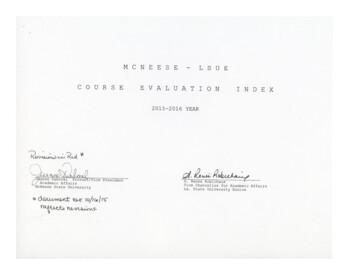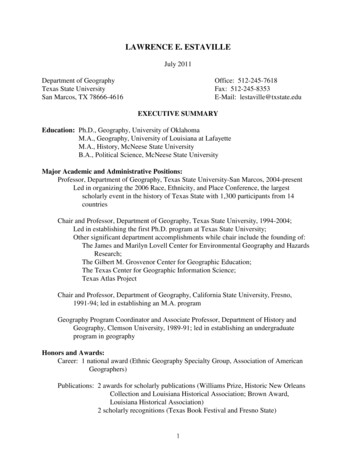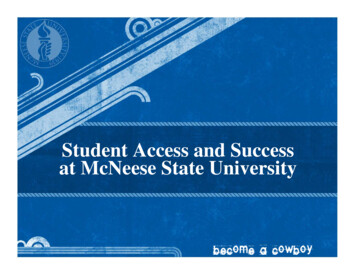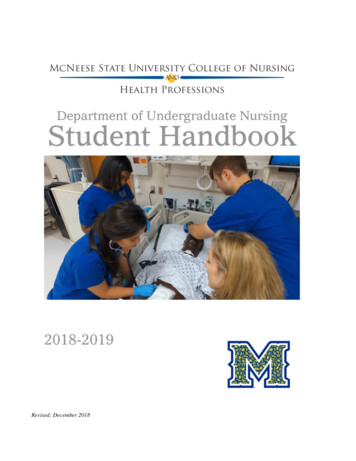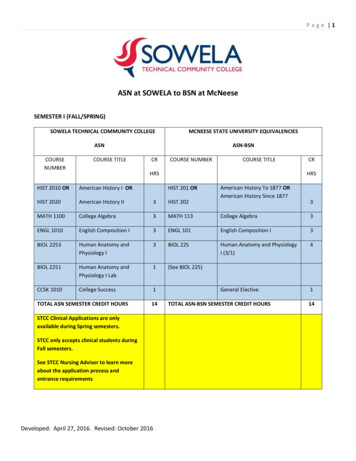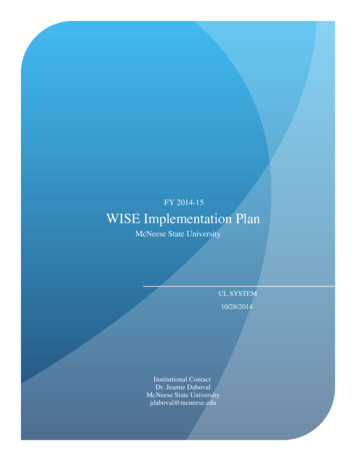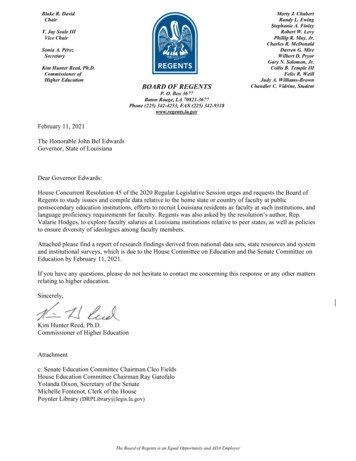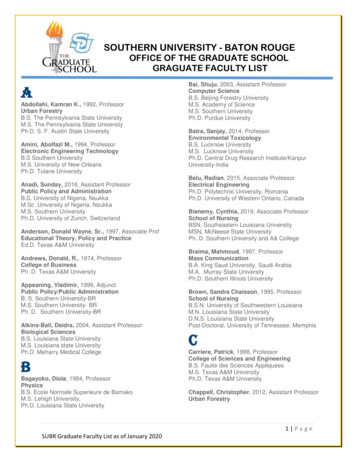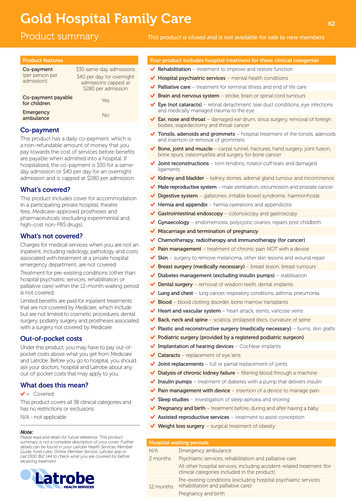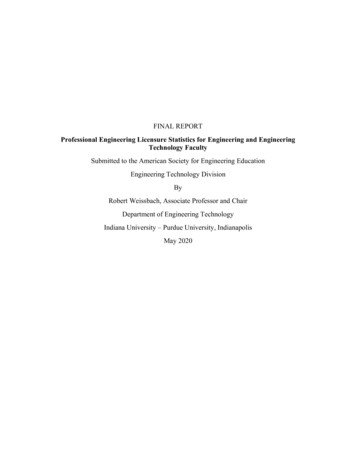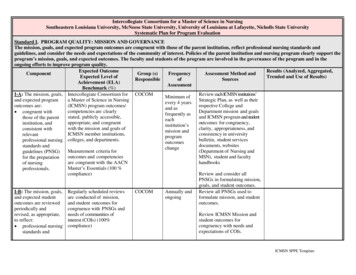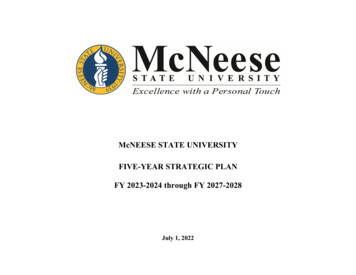
Transcription
McNEESE STATE UNIVERSITYFIVE-YEAR STRATEGIC PLANFY 2023-2024 through FY 2027-2028July 1, 2022
MCNEESE STATE UNIVERSITYTHE UNIVERSITY OF LOUISIANA SYSTEMStrategic Plan FY 2023-2024 through FY 2027-2028Our MissionMcNeese State University is a student-centric university whose mission is to change the lives of students through quality education andto provide services to the employers and communities in its region. McNeese uses a traditional admissions process based on coursescompleted, grade point average (GPA), and standardized test scores.AudiencesMcNeese is responsible for serving:a. Residents of southwest Louisiana who have completed high school and are seeking either a college degree or continuingprofessional education;b. Two-year college transfer students, particularly those from SOWELA Technical Community College;c. Employers in the region, both public and private, school districts, healthcare providers, local governments, and privatebusinesses;d. Economic development interests and regional entrepreneurs; ande. The area community, by providing a broad range of academic and cultural activities and public events.Array of Programs and Servicesa. An array of liberal arts programs at the baccalaureate level - arts and humanities, social sciences, natural sciences - appropriateto a teaching institution with a predominately undergraduate student body.b. Baccalaureate programs in education, engineering, business, nursing, selected allied health fields, mass communication, andcriminal justice.c. Master’s programs primarily related to education, engineering, arts, sciences, nursing, and business.d. Doctoral programs in professional fields.2
e. Support for area K-12 schools seeking college general education courses for advanced students and assistance in ensuring thattheir graduates are college- and career-ready.f. Services specifically designed to meet the needs of regional economic development, such as small business development, supportfor entrepreneurs, and problem solving.Special Programs/Featuresa. Programs in entrepreneurship and small business development supported by the Southwest Entrepreneurial and EconomicDevelopment (SEED) Center.b. Agricultural and related sciences with opportunities for experiential learning at three working farms and the Center forAdvancement of Meat Processing and Production (CAMPP).c. Custom academic programs and professional certifications integrated with area business and industry.d. Applied undergraduate research partnerships in engineering, sciences, and allied health.e. Cultural events designed to connect McNeese with the regional arts community and K-12 education.Our Vision: FIRST CHOICE!McNeese will be the first choice for Southwest Louisiana: The first choice for students seeking a university degree.The first choice for employers seeking university graduates.The first choice for donors wanting to support the community.The first choice for organizations seeking professional advice.The first choice for faculty and staff seeking a collegial and productive work environment.Our Statement of PurposeWe change lives through excellence with a personal touch! We change the lives of students through a mix of research, instruction, and student life activities, with a focus on student learningand mentorship. We provide a personal touch!We change lives in SWLA by improving the level of education and the overall economic development in our region. We provideexcellence!3
We improve the quality of life in SWLA through a range of academic and cultural activities and public events. We change lives!Our Pillars of ServiceWe support our state and our region through Three Pillars of Service: Stewardship: We will be good stewards of state resources and provide cost-effective education to our community.Engagement: We will engage with our community by providing employable graduates as well as by serving as a center forlearning and artistic creativity.Excellence: We will strive for excellence in all we do.Our Core ValuesTrust Trust we will act with honesty and integrity.Trust we will respect one another and the cultural differences among us.Trust we will have the courage to do the right thing.Trust we will do what is best for our students, our university, and our state.Mentorship Mentor our peers and inspire them to maintain excellence.Mentor our students and inspire them to achieve excellence.4
Goals and Objectives:Goal I: To Increase Opportunities for Student AccessObjective I.1: Increase the fall full term headcount enrollment at McNeese State University at the Fall 2021 baseline level of6,451 to 7,001 in the Fall 2026.Links: State Outcome Goals -- Youth Education, Diversified Economic GrowthChildren’s Budget Link: Not applicableHuman Resource Policies Beneficial to Women and Families Link: Not applicableOther Links: (TANF, Tobacco Settlement, Workforce Development Commission, or Other: Closely linked toobjective in Master Plan for Postsecondary EducationStrategy I.1.1:Recruit better academically prepared students.Strategy I.1.2:Develop collaborations with two-year schools to increase transfer rates.Strategy I.1.3:Enter into dual/cross/concurrent enrollment collaborations with community colleges.Strategy I.1.4:Develop need-based scholarship program to improve access and to encourage attendance.Strategy I.1.5:Implement or enhance initiatives geared towards improving graduation and retention rates.Performance Indicators:Output:Number of students enrolled (full term) in the University of Louisiana SystemOutcome:Percent change in the number of students enrolled (full term) in the University ofLouisiana SystemSource:Board of Regents Statewide Student Profile System data5
Goal II: To Increase Opportunities for Student SuccessObjective II.1: Increase the percentage of first-time in college, full-time, degree-seeking students retained to the second Fallat McNeese State University by 0.5 percentage points from the Fall 2020 cohort (to Fall 2021) baseline level of 68.7% to 69.2%by Fall 2026 (retention of Fall 2025 cohort).Links:State Outcome Goals: Youth Education, Diversified Economic GrowthChildren’s Budget Link: Not applicableHuman Resource Policies Beneficial to Women and Families Link: Not applicableOther Links: Board of Regents Master Plan for Postsecondary EducationStrategy I.1.1:Recruit better academically prepared studentsStrategy I.1.2:Develop need-based scholarship programs to improve retention, progression andgraduation.Strategy I.1.3:Implement or enhance initiatives geared towards improving retention, progression andgraduation rates.Performance Indicators:Output:Percentage of first-time in college, full-time, degree-seeking students retained to the second Fallat the same institution of initial enrollmentOutcome:Percentage point change in the percentage of first-time in college, full-time, degree-seekingstudents retained to the second Fall at the same institution of initial enrollmentSource:Board of Regents Statewide Student Profile System data6
Goal II: To Increase Opportunities for Student SuccessObjective II.2: Increase the percentage of first-time in college, full-time, degree-seeking students retained to the third Fall atMcNeese State University of initial enrollment by 0.6 percentage points from the Fall 2019 cohort (to Fall 2021) baseline levelof 57.0% to 57.6% by Fall 2026 (retention of Fall 2024 cohort).Links:State Outcome Goals: Youth Education, Diversified Economic GrowthChildren’s Budget Link: Not applicableHuman Resource Policies Beneficial to Women and Families Link: Not applicableOther Links: Board of Regents Master Plan for Postsecondary EducationStrategy I.1.1:Recruit better academically prepared studentsStrategy I.1.2:Develop need-based scholarship programs to improve retention, progression andgraduation.Strategy I.1.3:Implement or enhance initiatives geared towards improving retention, progression andgraduation rates.Performance Indicators:Output:Percentage of first-time in college, full-time, degree-seeking students retained to the third Fall atthe same institution of initial enrollmentOutcome:Percentage point change in the percentage of first-time in college, full-time, degree-seekingstudents retained to the third Fall at the same institution of initial enrollmentSource:Board of Regents Statewide Student Profile System data7
Goal II: To Increase Opportunities for Student SuccessObjective II.3: Increase the institutional statewide graduation rate (defined as a student completing an award within 150% of“normal time”) from the baseline rate (Fall 2014 cohort for all institutions) of 47.4% to 48.4% byAY 2025-2026 (Fall 2019 cohort).Links:State Outcome Goals: Youth Education, Diversified Economic GrowthChildren’s Budget Link: Not applicableHuman Resource Policies Beneficial to Women and Families Link: Not applicableOther Links: Board of Regents Master Plan for Postsecondary EducationStrategy I.1.1:Recruit better academically prepared studentsStrategy I.1.2:Develop need-based scholarship programs to improve retention, progression andgraduation.Strategy I.1.3:Implement or enhance initiatives geared towards improving retention, progression andgraduation rates.Performance Indicators:Output:Number of students enrolled at a Four Year University in LA identified in a first-time, full-time,degree-seeking cohort, graduating within 150% of "normal" time of degree completion from anypostsecondary institution in LA.Outcome:Percentage of students enrolled at a Four Year University identified in a first-time, full-time,degree-seeking cohort, graduating within 150% of "normal" time of degree completion from anypostsecondary institution in LA.Source:Board of Regents Statewide Graduation Rate8
Goal II: To Increase Opportunities for Student SuccessObjective II.4: Increase the total number of baccalaureate degree completers in a given academic year from the baseline yearnumber of 1,106 in 2020-2021 academic year to 1,120 in academic year 2025-2026 at McNeese. Students may only be countedonce per award level.Links:State Outcome Goals: Youth Education, Diversified Economic GrowthChildren’s Budget Link: Not applicableHuman Resource Policies Beneficial to Women and Families Link: Not applicableOther Links: Board of Regents Master Plan for Postsecondary EducationStrategy I.1.1:Recruit better academically prepared studentsStrategy I.1.2:Develop need-based scholarship programs to improve retention, progression andgraduation.Strategy I.1.3:Implement or enhance initiatives geared towards improving retention, progression andgraduation rates.Performance Indicators:Output:Number of completers at baccalaureate degree levelOutcome:Percentage change from baselineSource:Board of Regents Statewide Student Profile System9
Goal II: To Increase Opportunities for Student SuccessObjective II.5: Increase the total number of graduate degree completers in a given academic year from the baseline yearnumber of 213 in 2020-2021 academic year to 216 in academic year 2025-2026 at McNeese. Students may only be countedonce per award level.Links:State Outcome Goals: Youth Education, Diversified Economic GrowthChildren’s Budget Link: Not applicableHuman Resource Policies Beneficial to Women and Families Link: Not applicableOther Links: Board of Regents Master Plan for Postsecondary EducationStrategy I.1.1:Recruit better academically prepared studentsStrategy I.1.2:Develop need-based scholarship programs to improve retention, progression andgraduation.Strategy I.1.3:Implement or enhance initiatives geared towards improving retention, progression andgraduation rates.Performance Indicators:Output:Number of completers at graduate degree levelOutcome:Percentage change from baselineSource:Board of Regents Statewide Student Profile System10
Goal II: To Increase Opportunities for Student SuccessObjective II.6: Increase the total number of Undergraduate (adult, 25 years) completers in a given academic year from thebaseline year number of 329 in 2020-2021 academic year to 335 in academic year 2025-2026 at McNeese. Students may onlybe counted once per award level.Links:State Outcome Goals: Youth Education, Diversified Economic GrowthChildren’s Budget Link: Not applicableHuman Resource Policies Beneficial to Women and Families Link: Not applicableOther Links: Board of Regents Master Plan for Postsecondary EducationStrategy I.1.1:Recruit better academically prepared studentsStrategy I.1.2:Develop need-based scholarship programs to improve retention, progression andgraduation.Strategy I.1.3:Implement or enhance initiatives geared towards improving retention, progression andgraduation rates.Performance Indicators:Output:Number of completers at graduate degree levelOutcome:Percentage change from baselineSource:Board of Regents Statewide Student Profile System11
Goal II: To Increase Opportunities for Student SuccessObjective II.7: Increase the unduplicated number of underrepresented minorities (all races other than White, Asian, NonResidents and Unknown/Not Reported) completers in a given academic year from the baseline year number of 289 in 20202021 academic year to 300 in academic year 2025-2026 at McNeese. Students may only be counted once per award level.Links:State Outcome Goals: Youth Education, Diversified Economic GrowthChildren’s Budget Link: Not applicableHuman Resource Policies Beneficial to Women and Families Link: Not applicableOther Links: Board of Regents Master Plan for Postsecondary EducationStrategy I.1.1:Recruit better academically prepared studentsStrategy I.1.2:Develop need-based scholarship programs to improve retention, progression andgraduation.Strategy I.1.3:Implement or enhance initiatives geared towards improving retention, progression andgraduation rates.Performance Indicators:Output:Number of completers at graduate degree levelOutcome:Percentage change from baselineSource:Board of Regents Statewide Student Profile System12
Appendix AProcess DocumentationI.A brief statement identifying the principal clients and users of each program and the specific service or benefit derivedby such persons or organizations:The principal beneficiaries of the University’s programs are the 6451 students enrolled in university courses and degreeprograms. These students come principally from Southwest Louisiana. Secondary beneficiaries are the citizens of the parishesand the state of Louisiana who benefit from the University’s programs and facilities. The specific services or benefits derivedby the students and citizens will be the opportunities for high-quality postsecondary education. The ultimate benefit to thecommunity and prospective employers will be a better-educated and trained citizenry.II.An identification of potential external factors that are beyond the control of the entity and that could significantly affectthe achievement of its goals or objectives:Potential external factors could include: national, state, and local economic trends; and changes in the level of funding supportfrom the Louisiana Legislature. A change in policy at the federal level can have dramatic effects on postsecondary education,including student financial aid, research and experimentation, telecommunications (distance learning), and related programs.III.The statutory requirement or other authority for the goals of the plan:Goal 1: To Increase Opportunities for Student AccessGoal 2: To Increase Opportunities for Student SuccessConstitution (Article VIII, Sections 5 (D) 4) – To formulate and make timely revision of a master plan. Similarstatutory language appears in Title 17 of the Louisiana Revised StatutesConstitution (Article VIII, Section 5 (D) 1, 2) – To revise or eliminate existing academic programs and to approve ordisapprove new program proposals. Similar statutory language appears in Title 17 of the Louisiana Revised StatutesConstitution (Article VIII, Section 5 (D) 3) – To study the need for changes in mission of existing institutions. Similarstatutory language appears in Title 17 of the Louisiana Revised StatutesIV.A description of any program evaluation used to develop objectives and strategies.13
The Board of Regents is required by the state Constitution to develop and make timely revision of a master plan for highereducation. The goals and objectives in this five-year strategic plan were derived from the Regents’ revised Master Plan.STRATEGY ANALYSIS CHECKLIST Analysis Cost-benefit analysis conducted Financial or performance audit usedX Benchmarking for best management practices usedX Act 160 Reports used Other analysis or evaluation tools used Impact on other strategies considered Stakeholders identified and involved Authorization Authorization existsX Authorization needed Organization CapacityX Needed structural or procedural changes identifiedX Resource needs identified Strategies developed to implement needed changes or address resource needs Responsibility assigned Time Frame Already ongoing New, startup date estimated Lifetime of strategy identified Fiscal Impact Impact on operating budgetX Impact on capital outlay budgetX Means of finance identified Return on investment determined to be favorable14
V.Identification of the primary persons who will benefit from or be significantly affected by each objective within the plan.All goals, all objectives: Students, parents, faculty, employers, and the citizenry of the stateVI.An explanation of how duplication of effort will be avoided when the operations of more than one program are directedat achieving a single goal, objective, or strategy.For the purposes of Act 1465 of 1997, McNeese State University is a single program. Duplication of effort of more than oneprogram is therefore not applicable.VII.Documentation as to the validity, reliability, and appropriateness of each performance indicator, as well as the methodused to verify and validate the performance indicators as relevant measures of each program’s performance.See Performance Indicator Documentation attached for each performance indicator.VIII. A description of how each performance indicator is used in management decision making and other agency processes.See Performance Indicator Documentation attached for each performance indicator.15
Appendix BPerformance Indicator DocumentationProgram:McNeese State UniversityObjective I.1: Increase the fall full term headcount enrollment at McNeese State University at the Fall 2021 baseline level of6,451 to 7,001 in the Fall 2026.Indicator 1: Number of students enrolled (as of fall full term)1.What is the type of indicator?Output, Key2.What is the rationale for the indicator?Recognition of the importance of Louisiana having an educated citizenry.3.What is the source of the indicator? How reliable is the source?Data will be retrieved from the Board of Regents’ Statewide Student Profile System (SSPS). This system has been in existencefor over 25 years and is considered reliable.4.What is the frequency and timing of collection or reporting?The data are gathered three times annually, in the fall, spring, and summer. For this indicator, fall data (the national standard)will be used. The indicator will be reported at the end of the third quarter. This will allow time for collection, aggregation, andediting of the data.5.How is the indicator calculated? Is this a standard calculation?The method for reporting headcount enrollment is as of the end of the semester (full term). The Regents’ SSPS is a unit recordsystem where each enrolled student, regardless of course load, is counted.16
6.Does the indicator contain jargon, acronyms, or unclear terms? If so, clarify or define them.Headcount enrollment refers to the actual number of students enrolled [as opposed to full-time equivalent enrollment (FTE)which is calculated from the number of student credit hours enrolled divided by a fixed number].7.Is the indicator an aggregate or disaggregate figure?This indicator is the aggregate of all enrolled students at McNeese State University.8.Who is responsible for data collection, analysis, and quality?Each university submits the SSPS data electronically to the Board of Regents. The Board of Regents performs numerous editsand works with the campuses/system to correct errors. When all campus submissions are complete, the Regents’ staff builds amaster file for SSPS.9.Does the indicator have limitations or weaknesses? If so, explain. Is the indicator a proxy or surrogate? Does the sourceof the data have a bias or agenda?No weaknesses. This indicator reflects headcount enrollment and is not the enrollment calculation used for funding orreimbursement calculations.10.How will the indicator be used in management decision making and other agency processes?Enrollment drives many management decisions. The size of an institution’s enrollment impacts scheduling, hiring, futureplanning, program demands, facilities management, etc.17
Program:McNeese State UniversityObjective I.1: Increase the fall full term headcount enrollment at McNeese State University at the Fall 2021 baseline level of6,451 to 7,001 in the Fall 2026.Indicator 2: Percentage change in the number of students enrolled (as of fall full term) (compared to baseline)1.What is the type of indicator?Outcome, Supporting2.What is the rationale for the indicator?Recognition of the importance of Louisiana having an educated citizenry.3.What is the source of the indicator? How reliable is the source?Data will be retrieved from the Board of Regents’ Statewide Student Profile System (SSPS). This system has been in existencefor over 25 years and is considered reliable.4.What is the frequency and timing of collection or reporting?The data are gathered three times annually, in the fall, spring, and summer. For this indicator, fall data (the national standard)will be used.5.How is the indicator calculated? Is this a standard calculation?The method practiced nationwide for reporting headcount enrollment is as of the end of the semester (full term). The Regents’SSPS is a unit record system where each enrolled student, regardless of course load, is counted.6.Does the indicator contain jargon, acronyms, or unclear terms? If so, clarify or define them.Headcount enrollment refers to the actual number of students enrolled [as opposed to full-time equivalent enrollment (FTE)which is calculated from the number of student credit hours enrolled divided by a fixed number].7.Is the indicator an aggregate or disaggregate figure?This indicator is the aggregate of all enrolled students at McNeese State University.18
8.Who is responsible for data collection, analysis, and quality?Each university submits the SSPS data electronically to the Board of Regents. The Board of Regents performs numerous editsand works with the campuses/system to correct errors. When all campus submissions are complete, the Regents’ staff builds amaster file for SSPS.9.Does the indicator have limitations or weaknesses? If so, explain. Is the indicator a proxy or surrogate? Does the sourceof the data have a bias or agenda?No weaknesses. This indicator reflects headcount enrollment and is not the enrollment calculation used for funding orreimbursement calculations.10.How will the indicator be used in management decision making and other agency processes?Enrollment drives many management decisions. The size of an institution’s enrollment impacts scheduling, hiring, futureplanning, program demands, facilities management, etc.19
Program:McNeese State UniversityObjective II.1: Increase the percentage of first-time in college, full-time, degree-seeking students retained to the second Fall atMcNeese State University by 0.5 percentage points from the Fall 2020 cohort (to Fall 2021) baseline level of 68.7% to 69.2% byFall 2026 (retention of Fall 2025 cohort).Indicator 1: Percentage of first-time in college, full-time, degree-seeking students retained to the second Fall at the same institutionof initial enrollment1.What is the type of indicator?Output, Key2.What is the rationale for the indicator?Retention rates in System universities have improved in recent years. While System universities have been making strides inthis area, more improvement is needed. It is important for the further development of the state’s economy that a higherpercentage of students who enroll in a University of Louisiana System university be retained and eventually earn a degree.3.What is the source of the indicator? How reliable is the source?Data will be retrieved from the Board of Regents’ Statewide Student Profile System (SSPS). This system has been in existencefor over 25 years and is considered reliable.4.What is the frequency and timing of collection or reporting?The data are gathered three times annually, in the fall, spring, and summer. For this indicator, fall data (the national standard)will be used.5.How is the indicator calculated? Is this a standard calculation?The indicator will be calculated by matching the records of incoming full-time first-time freshmen enrolled in a fall semester tothe records of the following (second) fall semester. This is the national standard for the calculation of an institutional retentionrate.6.Does the indicator contain jargon, acronyms, or unclear terms? If so, clarify or define them.The measure only applies to a group of full-time, first-time freshmen who enter an institution in the Fall semester of a particularacademic year. They are tracked over time, to the next Fall semester.20
7.Is the indicator an aggregate or disaggregate figure?This indicator is the aggregate of all students in a full-time first-time freshmen cohort who remain enrolled in the second fallsemester.8.Who is responsible for data collection, analysis, and quality?Each university submits the SSPS data electronically to the Board of Regents. The Board of Regents performs numerous editsand works with the campuses/system to correct errors. When all campus submissions are complete, the Regents’ staff builds amaster file for SSPS.9.Does the indicator have limitations or weaknesses? If so, explain. Is the indicator a proxy or surrogate? Does the sourceof the data have a bias or agenda?No weaknesses.10.How will the indicator be used in management decision making and other agency processes?Ensuring student success drives many management decisions including recruitment, admissions, academic programming,academic support, facilities, and finance.21
Program:McNeese State UniversityObjective II.1: Increase the percentage of first-time in college, full-time, degree-seeking students retained to the second Fall atMcNeese State University by 0.5 percentage points from the Fall 2020 cohort (to Fall 2021) baseline level of 68.7% to 69.2% byFall 2026 (retention of Fall 2025 cohort).Indicator 2: Percentage point change in the percentage of first-time in college, full-time, degree-seeking students retained to thesecond Fall at the same institution of initial enrollment. (from baseline)1.What is the type of indicator?Outcome, Supporting2.What is the rationale for the indicator?Retention rates in System universities have improved in recent years. While System universities have been making strides inthis area, more improvement is needed. It is important for the further development of the state’s economy that a higherpercentage of students who enroll in a University of Louisiana System university be retained and eventually earn a degree.3.What is the source of the indicator? How reliable is the source?Data will be retrieved from the Board of Regents’ Statewide Student Profile System (SSPS). This system has been in existencefor over 25 years and is considered reliable.4.What is the frequency and timing of collection or reporting?The data are gathered three times annually, in the fall, spring, and summer. For this indicator, fall data (the national standard)will be used.5.How is the indicator calculated? Is this a standard calculation?The indicator will be calculated by matching the records of incoming full-time first-time freshmen enrolled in a fall semester tothe records of the following (second) fall semester. This is the national standard for the calculation of an institutional retentionrate. The percentage of students retained will be compared to the baseline.6.Does the indicator contain jargon, acronyms, or unclear terms? If so, clarify or define them.The measure only applies to a group of full-time, first-time freshmen who enter an institution in the Fall semester of a particularacademic year. They are tracked over time, to the next Fall semester.22
7.Is the indicator an aggregate or disaggregate figure?This indicator is the aggregate of all students in a full-time first-time freshmen cohort who remain enrolled in the second fallsemester. That figure is subtracted from the baseline to get a percentage change.8.Who is responsible for data collection, analysis, and quality?Each university submits the SSPS data electronically to the Board of Regents. The Board of Regents performs numerous editsand works with the campuses/system to correct errors. When all campus submissions are complete, the Regents’ staff builds amaster file for SSPS.9.Does the indicator have limitations or weaknesses? If so, explain. Is the indicator a proxy or surrogate? Does the sourceof the data have a bias or agenda?No weaknesses.10.How will the indicator be used in management decision making and other agency processes?Ensuring student success drives many management decisions including recruitment, admissions, academic programming,academic support, facilities, and finance.23
Program:McNeese State UniversityObjective II.2: Increase the percentage of first-time in college, full-time, degree-seeking students retained to the third Fall atMcNeese State University of initial enrollment by 0.6 percentage points from the Fall 2019 cohort (to Fall 2021) baseline levelof 57.0% to 57.6% by Fall 2026 (retention of Fall 2024 cohort).Indicator 1: Percentage of first-time in coll
McNeese State University is a student-centric university whose mission is to change the lives of students through quality education and to provide services to the employers and communities in its region. McNeese uses a traditional admissions process based on courses completed, grade point average (GPA), and standardized test scores. Audiences
